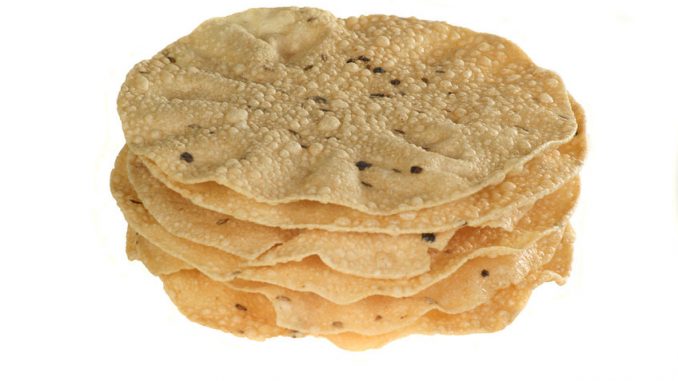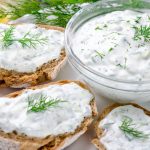
Here we make some poppadoms. No Indian restaurant is without this lovely flat bread. Great with dips such as cucumber and yogurt, or a classic Indian chutney.
Poppadoms, also known as papads or papadums, have a rich and varied history rooted in Indian culinary traditions. These thin, crispy flatbreads are not only a staple in Indian cuisine but also a beloved item in South Asian and even global kitchens. The history of poppadoms reflects the agricultural practices, cultural exchanges, and culinary innovations of the Indian subcontinent over centuries.
Ancient Origins
The exact origins of poppadoms are difficult to pinpoint, but they are believed to date back thousands of years. The concept of creating thin, dried, and fried or roasted flatbreads likely emerged from the need to preserve food. Early references to similar preparations can be found in ancient Indian texts and scriptures, suggesting that poppadoms were a part of the Indian diet long before recorded history.
Regional Variations and Ingredients
Poppadoms are made from a variety of flours, including lentil (urad dal), chickpea (gram), rice, and potato, reflecting the agricultural diversity of India. Each region in India has its own variation of poppadoms, shaped by the local climate, available ingredients, and culinary traditions.
- North India: In regions like Punjab and Uttar Pradesh, poppadoms made from urad dal flour are common. These are often seasoned with black pepper, cumin seeds, and sometimes asafoetida (hing).
- South India: Here, poppadoms made from rice flour or a mix of lentil flours are popular. In Tamil Nadu and Kerala, poppadoms are frequently served with rice dishes and curries.
- Western India: In Gujarat and Maharashtra, poppadoms can be made from chickpea flour and are typically flavored with a mix of spices including chili powder, garlic, and cumin.
- Eastern India: Poppadoms in Bengal and Odisha often use ingredients like mung bean flour and are spiced differently to suit local tastes.
Cultural Significance
Poppadoms hold significant cultural importance in Indian society. They are often prepared during festivals, family gatherings, and special occasions. The process of making poppadoms can be a communal activity, especially in rural areas where women come together to roll out and dry large batches under the sun. This not only ensures a steady supply for the household but also strengthens social bonds within the community.
Culinary Use and Adaptation
Over time, poppadoms have evolved from being simple, dried flatbreads to becoming an integral part of the Indian culinary landscape. They are served as appetizers, snacks, or accompaniments to main dishes. In many Indian restaurants, especially those catering to international clientele, poppadoms are often served with a variety of chutneys and pickles as a starter.
The British colonization of India played a significant role in popularizing poppadoms outside the subcontinent. British expatriates developed a taste for Indian cuisine, and upon returning home, they introduced dishes like poppadoms to the British palate. Today, poppadoms are a familiar feature in Indian restaurants worldwide, particularly in the UK.
Industrial Production
With the rise of industrialization and globalization, the production of poppadoms has seen significant changes. While traditional, handmade poppadoms are still widely available and preferred for their authentic taste and texture, mass production has made poppadoms more accessible globally. Brands like Lijjat, a cooperative established by women in India in 1959, have played a crucial role in this transformation. Lijjat Pappad has become synonymous with quality poppadoms, employing thousands of women and empowering them economically.
Modern Variations and Innovations
In contemporary times, the versatility of poppadoms has led to numerous innovations in their preparation and presentation. Flavored poppadoms, incorporating ingredients like spinach, tomato, garlic, and even exotic spices, cater to diverse tastes and preferences. Health-conscious consumers can find baked or roasted poppadoms that offer a lower-fat alternative to the traditional fried version.
Global Influence
Poppadoms have transcended their Indian origins to become a beloved item in global cuisine. They are particularly popular in the UK, where they are often served in Indian restaurants as an appetizer, typically with a selection of chutneys and dips. The adaptability of poppadoms has seen them incorporated into fusion dishes, used as a base for canapés, or even crumbled over salads for added texture.
Conclusion
The history of poppadoms is a testament to the rich culinary heritage of India and its ability to adapt and thrive through centuries of change. From their ancient origins as a means of preserving food to their modern-day presence in global cuisine, poppadoms have remained a beloved and integral part of the Indian dining experience. Their versatility, ease of preparation, and delightful crunch ensure that poppadoms will continue to be enjoyed by generations to come, both in India and around the world.
Here is a recipe for a standard style of papad or poppadom.
[Please note we are an affiliate marketing partner and will make a sales commission if you purchase any items through our affiliate links. Please read our affiliate disclosure]
Ingredients:
- 4oz white or urid flour
- 2oz rice flour
- ½ tsp turmeric powder for colour
- ½ tps pink rock salt
- 2 tsp coconut oil
- 40ml water
Preparation:
- Put the flour, turmeric and rock salt into a bowl and mix.
- Add the coconut oil and add the water a little at a time and stir to make a stiff dough. Knead until it’s smooth.
- Wrap the dough in cling film and let it rest for an hour at room temperature.
- Portion the dough into 6 equal sized balls and roll out to 1mm thickness. Use flour to dust your surface.
- Place the rolled out poppadoms on some kitchen roll to dry for 20 minutes.
- Heat some frying oil in a wok. Drop in a little of the dough if it sinks and rises then the oil is ready.
- Gentle place one poppadom into the oil and push under the oil until it bubbles and turns golden. Remove and set on some kitchen roll. Repeat with the remaining poppadoms.

What is the utensil you use to keep the poppodom flat
Hi Jude,
That’s a really interesting question because poppadoms have such a strong tendency to curl or form a frill. There isn’t really any particular utensil that can be used and the frilling/curling is considered a natural feature of this food. The main feature for a uniform ’round’ is the frying. Make sure the oil is at least at 190 Centigrade or 375 Fahrenheit. It needs to be a deep enough layer for the poppadom to float freely even in a wok. I would also suggest a heavy iron pan with the oil in it but that is cumbersome. Industrial producers press it in as soon as the flat dough hits the fat. The key is making sure the whole piece is submerged evenly because different frying times means different rates of heating and a tendency for the frying dough to almost take the shape of the wok which I suggested. Flip over after a few seconds. Judgement is needed to check if the 1st fry is done enough I’m afraid. If you overcook it also curls even more when it starts cooling although it should be really crispy by then! I might rewrite this article with these additional notes because frying them is an art!